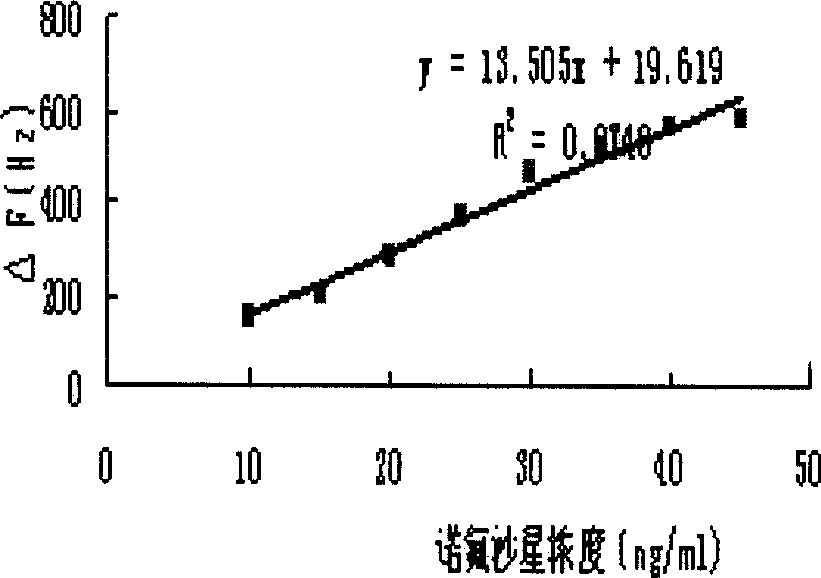A method for quick detection of fluo quinolone drug residual in foods
A fluoroquinolone and detection method technology, applied in the field of detection of drug residues in food, can solve the problems of difficulty in realizing miniaturization and portability, high requirements for operators' professional skills, low degree of equipment integration, etc. The effect of reduced analysis time, high sensitivity and accuracy
- Summary
- Abstract
- Description
- Claims
- Application Information
AI Technical Summary
Problems solved by technology
Method used
Image
Examples
Embodiment 1~2
[0032] Examples 1-2: Rapid detection of enrofloxacin and norfloxacin residues in pork
[0033] 1. Antibody preparation
[0034] First prepare phosphate buffered saline (0.01M, pH7.4, referred to as PBS): Take 8g of NaCl, 0.2g of KCl, NaCl 2 HPO 4 12H 2 O 2.9g, KH 2 PO 4 2.0g, add double-distilled water to 1000mL, pass through a 0.22μm membrane, and store at room temperature.
[0035] Take 3 mg of enrofloxacin or norfloxacin, 10 mg of N-hydroxysuccinamide, and 10 mg of 1-ethyl-3 (3-dimethylaminopropyl) carbodiimide, and add them in sequence to 1.5 mL dissolved in 6 mg of bovine Serum albumin and PBS containing 33% DMF (v / v), shake overnight at room temperature, then dialyze the reactant with PBS, freeze-dry, the product is the complete antigen, and store it at -80°C for future use.
[0036] After mixing 1 mg of complete antigen with 1.0 mL of normal saline and 1.0 mL of Freund's complete adjuvant, New Zealand rabbits were injected subcutaneously at multiple points on the...
Embodiment 3
[0049] Embodiment 3: the detection effect of the present invention and its comparison with HPLC method
[0050] Table 1 HPLC method for the detection effect of spiked pork (n=3)
[0051] Spiked Concentration (μg / kg)
[0052] Table 2 The present invention is for the detection effect of standard-added pork (n=3)
[0053] Spiked Concentration (μg / kg)
[0054] Table 3 The detection results of the two methods for commercially available pork samples (n=3)
[0055] drug
[0056] At present, the requirements for fluoroquinolone drug residues in food at home and abroad vary according to different drug varieties and different food types, but the minimum detection limit is generally required to be above 50 μg / kg. Tables 1-3 show that for drug residues with a concentration above 25 μg / kg, the average recovery rate of the present invention is higher than 75%, RSD is within 10%, and has good correlation wit...
PUM
 Login to View More
Login to View More Abstract
Description
Claims
Application Information
 Login to View More
Login to View More - R&D
- Intellectual Property
- Life Sciences
- Materials
- Tech Scout
- Unparalleled Data Quality
- Higher Quality Content
- 60% Fewer Hallucinations
Browse by: Latest US Patents, China's latest patents, Technical Efficacy Thesaurus, Application Domain, Technology Topic, Popular Technical Reports.
© 2025 PatSnap. All rights reserved.Legal|Privacy policy|Modern Slavery Act Transparency Statement|Sitemap|About US| Contact US: help@patsnap.com



